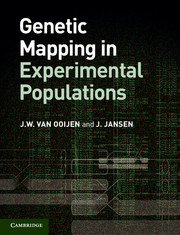Book contents
- Frontmatter
- Contents
- Preface
- 1 Introduction
- 2 Meiosis and genetic recombination
- 3 Estimation of recombination frequencies
- 4 Determination of linkage groups
- 5 Estimation of a genetic map
- 6 Criteria for the evaluation of maps
- 7 How to find the best map order
- 8 Outbreeding species
- 9 Mapping in practice
- Answers to exercises
- Index
- References
5 - Estimation of a genetic map
Published online by Cambridge University Press: 05 August 2013
- Frontmatter
- Contents
- Preface
- 1 Introduction
- 2 Meiosis and genetic recombination
- 3 Estimation of recombination frequencies
- 4 Determination of linkage groups
- 5 Estimation of a genetic map
- 6 Criteria for the evaluation of maps
- 7 How to find the best map order
- 8 Outbreeding species
- 9 Mapping in practice
- Answers to exercises
- Index
- References
Summary
The central idea of linkage analysis is that the rate of recombination between two loci is a reflection of their mutual distance on the chromosomes. Combining recombination frequencies between multiple loci on the same chromosome allows determination of the relative positions of these loci on the chromosome, thus creating a linkage map. A linkage map is defined by the order of its loci and by their mutual distances. This chapter is about obtaining the map distances for a given order.
Recombination frequencies and distances
One of the functions of a linkage map is to allow easy calculation of recombination frequencies between loci from their positions on the map. The linearity of a linkage map implies that distances can be added or subtracted. The question is whether recombination frequencies can be used as map distances. This problem was initially met by Sturtevant (1913), who was the first person to produce a genetic linkage map. At the time, it was becoming clear that genetic factors were located on the chromosomes. Sturtevant realized that it should be possible to determine the spatial arrangement of the genetic factors on the linear structure of a chromosome using recombination frequencies between factors as measures of their mutual distances. However, he found a discrepancy between the sum of adjacent distances and the direct measurement of the overall distance. He claimed that shorter distances were measured more accurately. He attributed the discrepancy to double recombinations and to a phenomenon now known as crossover interference. The essence of the problem is that recombination frequencies are not additive. The problem was solved by Haldane (1919), who derived a function that translates recombination frequencies into additive distances.
Information
- Type
- Chapter
- Information
- Genetic Mapping in Experimental Populations , pp. 59 - 76Publisher: Cambridge University PressPrint publication year: 2013
